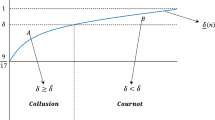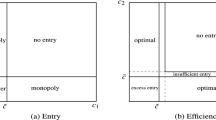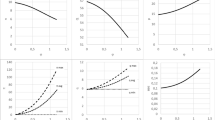Abstract
We consider a free entry, symmetric cost, Cournot equilibrium in a homogeneous product market. There is a parameter A which is the index of the “market size” . If a firm decides to enter, it must incur set-up costs of F. We explore the following question: How do the number of firms, individual output and total output in a free entry equilibrium change with an increase in the market size and entry cost? Conventional wisdom suggests that these should increase with A and decrease with F. However, we show this may not be true. We use the implicit function theorem to provide a complete characterization. We also illustrate our results with specific examples.


Similar content being viewed by others
Notes
There is an interesting example in Vives (1999, chapter 4, section 4.3.2, page-109 ), which is somewhat related to our exercise. \(P=A/Q\) and costs \(C(q_{i})=q^{\frac{1}{2}}\) with \(F=0\). At a n-firm symmetric Corunot equilibrum, \(q^{*}=\left[ \frac{2\left( n-1\right) A}{n^{2}}\right] ^{2}\) . Cournot profits per firm is \(\frac{A}{n^{2}}\left[ 2-n\right]\). Clearly, there will be at most two firms in the market for any A (even with zero entry cost).
The structure and assumptions are similar to Dastidar (2010).
It appears that the equilibrium in one-stage and two-stage entry games are related when outputs are strategic substitutes. However, when outputs are strategic complements this relation is not very clear and this aspect needs further investigation. We are very grateful to the anonymous referee for highlighting this point.
In the Mankiw-Whinston model if one takes into account the integer constraint (i.e., the number of firms must be an integer), free entry may be insufficient but never by more than one firm.
See (Seade 1980a) for some related results on stability.
References
Amir R, Lambson VE (2000) On the effects of entry in Cournot markets. Rev Econ Stud 67:235–254
Bulow J, Geanakoplos J, Klemperer P (1985) Multimarket oligopoly: strategic substitutes and complements. J Polit Econ 93:488–511
Corchon LC, Fradera I (2002) Comparative statics in Cournot free entry equilibrium. Math Soc Sci 44:155–168
Dastidar KG (2000) Is a unique Cournot equilibrium locally stable? Games Econom Behav 32:206–218
Dastidar KG (2010) Reflecting on market size and entry under oligopoly in Econophysics and Economics of Games. In: Basu B, Chakrabarti BK, Chakravarty SR, Gangopadhyay K (eds.) Social choices and quantitative techniques, Springer, Leipzig
Galera F, Garcia-del-Barrio P (2011) Excessive entry and the integer constraint with many firms: a note. J Econ 103:271–287
Gaudet G, Salant SW (1991) Uniqueness of Cournot equilibrium: new results from old methods. Rev Econ Stud 58:399–404
Gotz G (2005) Market size, technology choice, and the existence of free-entry Cournot equilibrium. J Inst Theor Econ 161:503–521
Harrington JE (1991) The joint profit maximum as a free-entry equilibrium outcome. Eur Econ Rev 35:1087–1101
Kolstad CD, Mathiesen L (1987) Necessary and sufficient conditions for uniqueness of a Cournot equilibrium. Rev Econ Stud 54:681–690
Lopez-Cunat JM (1999) One stage and two stage Cournot equilibria. Investigaciones Economicas 23:115–128
Mankiw GN, Whinston MD (1986) Free entry and social inefficiency Rand. J Econ 17:48–58
Novshek W (1980) Cournot equilibrium with free entry. Rev Econ Stud 47:473–486
Okumura Y (2015) Existence of free entry equilibrium in aggregative games with asymmetric agents. Econ Lett 127:14–16
Seade J (1980a) The stability of Cournot revisited. J Econ Theor 23:15–27
Seade J (1980) On the effects of entry. Econometrica 48:479–489
Vives X (1999) Oligopoly pricing: old ideas and new tools. MIT Press, Cambridge
Author information
Authors and Affiliations
Corresponding author
Additional information
Publisher's Note
Springer Nature remains neutral with regard to jurisdictional claims in published maps and institutional affiliations.
We dedicate this paper to the memory of Dave Furth. Long back Dave Furth had discussed some of the ideas in the paper with K. G. Dastidar, who fondly remembers him. The authors are deeply indebted to Giacomo Corneo and an anonymous referee for a set of excellent comments.
Appendix
Appendix
Computation of \(\det Z\)
Note that
Hence,
Hence,
From above we get that
Proof of lemma 1
Note that \(P_{1}\left( .\right) <0\) and from (5b) we have \(q^{*}P_{11}\left( n^{e}q^{*},A\right) +2P_{1}\left( n^{e}q^{*},A\right) -C^{\prime \prime }\left( q^{*}\right) <0\). Consequently, by using (9) we get that \(\det Z>0\).\(\blacksquare\)
Proof of Proposition 1
-
(i)
Note that
$$\begin{aligned}&\det \left| \begin{array}{ll} \frac{\partial Z_{1}}{\partial q} &{} \frac{\partial Z_{1}}{\partial A} \\ \frac{\partial Z_{2}}{\partial q} &{} \frac{\partial Z_{2}}{\partial A} \end{array} \right| \nonumber \\&=\det \left| \begin{array}{ll} n^{e}q^{*}P_{11}\left( .\right) +\left( n^{e}+1\right) P_{1}\left( .\right) -C^{\prime \prime }\left( .\right) &{} q^{*}P_{12}\left( .\right) +P_{2}\left( .\right) \\ \left( n^{e}-1\right) q^{*}P_{1}\left( .\right) &{} q^{*}P_{2}\left( .\right) \end{array} \right| \nonumber \\&=q^{*}\left[ \begin{array}{c} n^{e}q^{*}P_{11}\left( .\right) P_{2}\left( .\right) +2P_{1}\left( .\right) P_{2}\left( .\right) \\ -P_{2}\left( .\right) C^{\prime \prime }\left( .\right) -\left( n^{e}-1\right) q^{*}P_{1}\left( .\right) P_{12}\left( .\right) \end{array} \right] \end{aligned}$$(10)From the implicit function theorem we know that
$$\begin{aligned} \frac{\partial n^{e}}{\partial A}=-\frac{\det \left| \begin{array}{ll} \frac{\partial Z_{1}}{\partial q} &{} \frac{\partial Z_{1}}{\partial A} \\ \frac{\partial Z_{2}}{\partial q} &{} \frac{\partial Z_{2}}{\partial A} \end{array} \right| }{\det Z} \end{aligned}$$(11)Since \(\det Z>0\) and \(q^{*}>0\), using (10) and (11) we get that
$$\begin{aligned}&\frac{\partial n^{e}}{\partial A}>0\Leftrightarrow n^{e}q^{*}P_{11}\left( .\right) P_{2}\left( .\right) +2P_{1}\left( .\right) P_{2}\left( .\right) -P_{2}\left( .\right) C^{\prime \prime }\left( .\right) \\&-\left( n^{e}-1\right) q^{*}P_{1}\left( .\right) P_{12}\left( .\right) <0. \end{aligned}$$ -
(ii)
Note that
$$\begin{aligned}&\det \left| \begin{array}{ll} \frac{\partial Z_{1}}{\partial q} &{} \frac{\partial Z_{1}}{\partial F} \\ \frac{\partial Z_{2}}{\partial q} &{} \frac{\partial Z_{2}}{\partial F} \end{array} \right| \nonumber \\&=\det \left| \begin{array}{ll} n^{e}q^{*}P_{11}\left( .\right) +\left( n^{e}+1\right) P_{1}\left( .\right) -C^{\prime \prime }\left( .\right) &{} 0 \\ \left( n^{e}-1\right) q^{*}P_{1}\left( .\right) &{} -1 \end{array} \right| \nonumber \\&=-\left[ n^{e}q^{*}P_{11}\left( .\right) +\left( n^{e}+1\right) P_{1}\left( .\right) -C^{\prime \prime }\left( .\right) \right] \nonumber \\&=-\left[ \left( n^{e}-1\right) \left\{ q^{*}P_{11}\left( .\right) +P_{1}\left( .\right) \right\} +q^{*}P_{11}\left( .\right) +2P_{1}\left( .\right) -C^{\prime \prime }\left( .\right) \right] \nonumber \\&=-\left[ \left( n^{e}-1\right) b+a\right] \end{aligned}$$(12)From the implicit function theorem we know that
$$\begin{aligned} \frac{\partial n^{e}}{\partial F}=-\frac{\det \left| \begin{array}{ll} \frac{\partial Z_{1}}{\partial q} &{} \frac{\partial Z_{1}}{\partial F} \\ \frac{\partial Z_{2}}{\partial q} &{} \frac{\partial Z_{2}}{\partial F} \end{array} \right| }{\det Z} \end{aligned}$$(13)Since \(\det Z>0\), using (12) and (13) we get \(\frac{\partial n^{e}}{\partial F}<0\Leftrightarrow \left[ \left( n^{e}-1\right) b+a\right] <0.\) Using (3) we know that \(\left( n^{e}-1\right) b+a<0\). Hence, \(\frac{\partial n^{e}}{ \partial F}<0\).\(\blacksquare\)
Proof of Proposition 2
-
(i)
Note that
$$\begin{aligned}&\det \left| \begin{array}{ll} \frac{\partial Z_{1}}{\partial A} &{} \frac{\partial Z_{1}}{\partial n} \\ \frac{\partial Z_{2}}{\partial A} &{} \frac{\partial Z_{2}}{\partial n} \end{array} \right| \nonumber \\&=\det \left| \begin{array}{ll} q^{*}P_{12}\left( .\right) +P_{2}\left( .\right) &{} \left( q^{*}\right) ^{2}P_{11}\left( .\right) +q^{*}P_{1}\left( .\right) \\ q^{*}P_{2}\left( .\right) &{} \left( q^{*}\right) ^{2}P_{1}\left( .\right) \end{array} \right| \nonumber \\&=\left( q^{*}\right) ^{3}\left[ P_{1}\left( .\right) P_{12}\left( .\right) -P_{11}\left( .\right) P_{2}\left( .\right) \right] \end{aligned}$$(14)From the implicit function theorem we know that
$$\begin{aligned} \frac{\partial q^{*}}{\partial A}=-\frac{\det \left| \begin{array}{cc} \frac{\partial Z_{1}}{\partial A} &{} \frac{\partial Z_{1}}{\partial n} \\ \frac{\partial Z_{2}}{\partial A} &{} \frac{\partial Z_{2}}{\partial n} \end{array} \right| }{\det Z} \end{aligned}$$(15)Since \(\det Z>0\) and \(q^{*}>0\), using (14) and (15) we get that
$$\begin{aligned} \frac{\partial q^{*}}{\partial A}>0\Leftrightarrow P_{1}\left( .\right) P_{12}\left( .\right) -P_{11}\left( .\right) P_{2}\left( .\right) <0. \end{aligned}$$ -
(ii)
Note that
$$\begin{aligned}&\det \left| \begin{array}{ll} \frac{\partial Z_{1}}{\partial F} &{} \frac{\partial Z_{1}}{\partial n} \\ \frac{\partial Z_{2}}{\partial F} &{} \frac{\partial Z_{2}}{\partial n} \end{array} \right| \nonumber \\&=\det \left| \begin{array}{ll} 0 &{} \left( q^{*}\right) ^{2}P_{11}\left( .\right) +q^{*}P_{1}\left( .\right) \\ -1 &{} \left( q^{*}\right) ^{2}P_{1}\left( .\right) \end{array} \right| \nonumber \\&=q^{*}\left[ q^{*}P_{11}\left( .\right) P_{1}\left( .\right) \right] \end{aligned}$$(16)From the implicit function theorem we know that
$$\begin{aligned} \frac{\partial q^{*}}{\partial F}=-\frac{\det \left| \begin{array}{ll} \frac{\partial Z_{1}}{\partial F} &{} \frac{\partial Z_{1}}{\partial n} \\ \frac{\partial Z_{2}}{\partial F} &{} \frac{\partial Z_{2}}{\partial n} \end{array} \right| }{\det Z} \end{aligned}$$(17)Since \(\det Z>0\) and \(q^{*}>0\), using (16) and (17) we get that \(\frac{ \partial q^{*}}{\partial F}>0\Leftrightarrow q^{*}P_{11}\left( .\right) +P_{1}\left( .\right) <0\).\(\blacksquare\)
Proof of Proposition 3
-
(i)
Note that using (11) and (15) and some routine computations we get
$$\begin{aligned} \frac{\partial \left( n^{e}q^{*}\right) }{\partial A}&=n^{e}\frac{ \partial q^{*}}{\partial A}+q^{*}\frac{\partial n^{e}}{\partial A} \nonumber \\&=-\frac{1}{\det Z}\left[ n^{e}\det \left| \begin{array}{ll} \frac{\partial Z_{1}}{\partial A} &{} \frac{\partial Z_{1}}{\partial n} \\ \frac{\partial Z_{2}}{\partial A} &{} \frac{\partial Z_{2}}{\partial n} \end{array} \right| +q^{*}\det \left| \begin{array}{ll} \frac{\partial Z_{1}}{\partial q} &{} \frac{\partial Z_{1}}{\partial A} \\ \frac{\partial Z_{2}}{\partial q} &{} \frac{\partial Z_{2}}{\partial A} \end{array} \right| \right] \nonumber \\&=-\frac{\left( q^{*}\right) ^{2}}{\det Z}\left[ q^{*}P_{1}\left( .\right) P_{12}\left( .\right) +2P_{1}\left( .\right) P_{2}\left( .\right) -P_{2}\left( .\right) C^{\prime \prime }\left( .\right) \right] \end{aligned}$$(18)Since \(\det Z>0\) and \(q^{*}>0\), from (18) we have
$$\begin{aligned} \frac{\partial \left( n^{e}q^{*}\right) }{\partial A}>0\Leftrightarrow \left[ q^{*}P_{1}\left( .\right) P_{12}\left( .\right) +2P_{1}\left( .\right) P_{2}\left( .\right) -P_{2}\left( .\right) C^{\prime \prime }\left( .\right) \right] <0. \end{aligned}$$ -
(ii)
Note that using (13) and (17) we get
$$\begin{aligned} \frac{\partial \left( n^{e}q^{*}\right) }{\partial F}&=n^{e}\frac{ \partial q^{*}}{\partial F}+q^{*}\frac{\partial n^{e}}{\partial F} \nonumber \\&=-\frac{1}{\det Z}\left[ n^{e}\det \left| \begin{array}{cc} \frac{\partial Z_{1}}{\partial F} &{} \frac{\partial Z_{1}}{\partial n} \\ \frac{\partial Z_{2}}{\partial F} &{} \frac{\partial Z_{2}}{\partial n} \end{array} \right| +q^{*}\det \left| \begin{array}{cc} \frac{\partial Z_{1}}{\partial q} &{} \frac{\partial Z_{1}}{\partial F} \\ \frac{\partial Z_{2}}{\partial q} &{} \frac{\partial Z_{2}}{\partial F} \end{array} \right| \right] \nonumber \\&=-\frac{q^{*}}{\det Z}\left[ -P_{1}\left( .\right) +C^{\prime \prime }\left( .\right) \right] \end{aligned}$$(19)Since \(\det Z>0\) and \(q^{*}>0\), from (19) we have \(\frac{\partial \left( n^{e}q^{*}\right) }{\partial F}<0\Leftrightarrow \left[ -P_{1}\left( .\right) +C^{\prime \prime }\left( .\right) \right] >0\). Note that from Assumption (4) we get that \(\left[ -P_{1}\left( .\right) +C^{\prime \prime }\left( .\right) \right] >0\). Hence, \(\frac{\partial \left( n^{e}q^{*}\right) }{\partial F}<0\).\(\blacksquare\)
Rights and permissions
About this article
Cite this article
Dastidar, K.G., Marjit, S. Market size, entry costs and free entry Cournot equilibrium. J Econ 136, 97–114 (2022). https://doi.org/10.1007/s00712-021-00769-1
Received:
Accepted:
Published:
Issue Date:
DOI: https://doi.org/10.1007/s00712-021-00769-1




